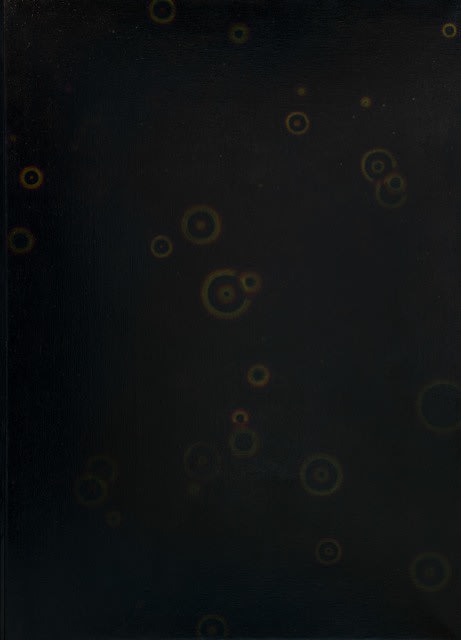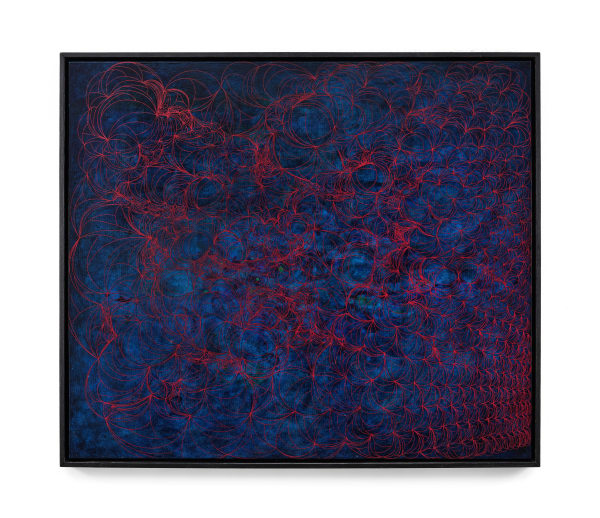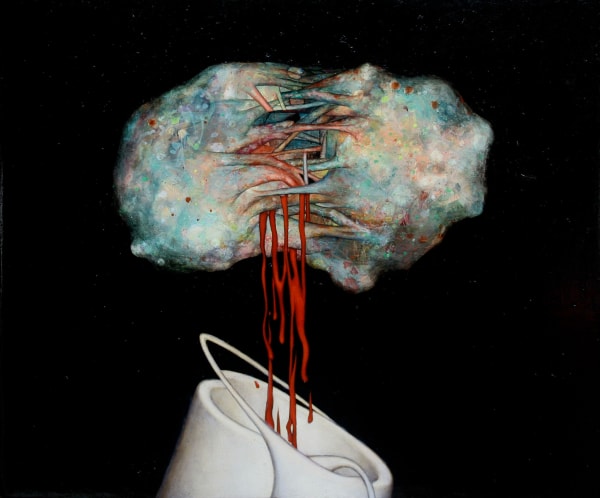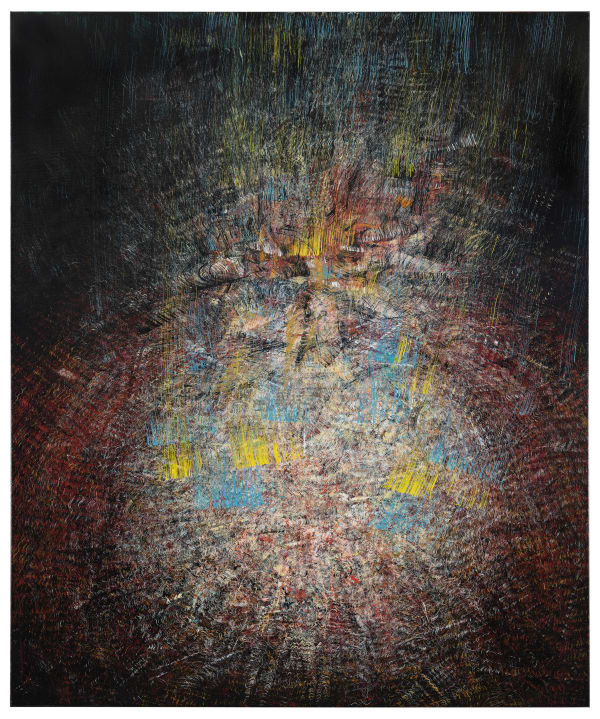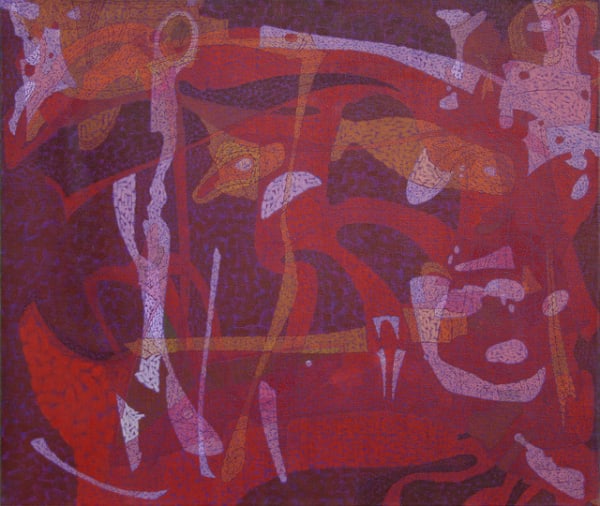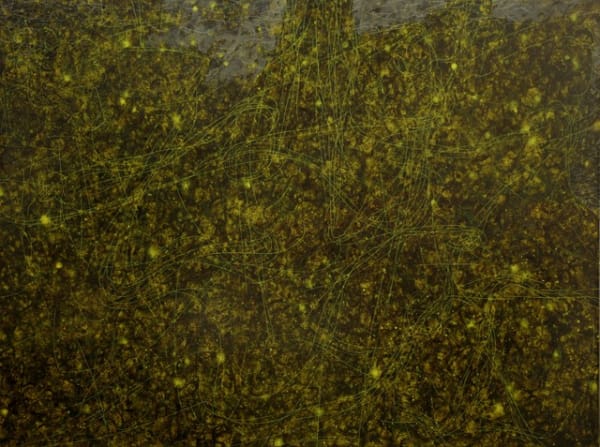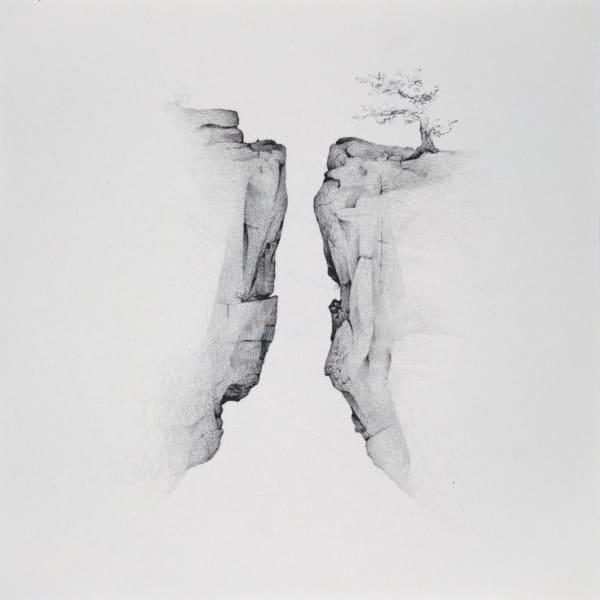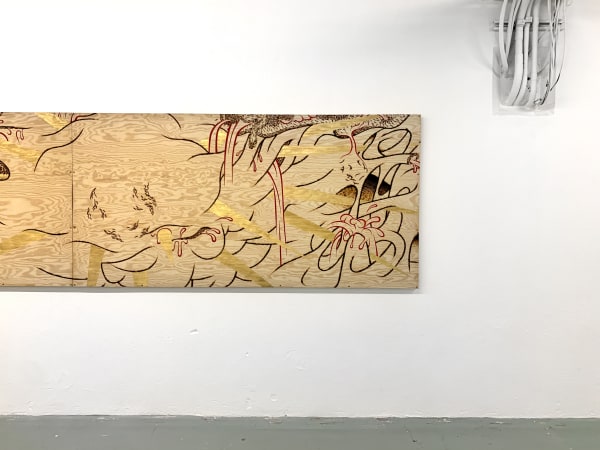Johnathan Daily Swedish-American , b. 1974
Daily considers his combination of colors to be very impressionistic – not in terms of brushstrokes, but in the way he combines colors. He has coined this process as ‘three-dimensional color’ explaining how, in order to create one color, you need to use other colors to support it.
Johnathan Daily, b. 1974, is an Swedish-American artist based today in Stockholm, Sweden. Daily graduated with a B.F.A. from the Minneapolis College of Art and Design in 1999, and prior to that attended the Milwaukee Institute of Art and Design.
Blixtfisket: Catching the thoughts behind the artistic practice of painter Johnathan Daily
Written by Anne Klontz.
I was first introduced to the works of Johnathan Daily during a visit to his studio in Stockholm, where a large new painting was in the center of the room. While in conversation with the artist I observed this painting from a distance, seeing it as a black seascape with reflections of white moonlight on water. When I could eventually take a closer look at the painting, De Döda (2022), I became transfixed by the work’s complexity as reds and blues emerged from the black that I didn’t see at first glance, and the white moonlight wasn’t white but layers of soft pastel colors. De Döda is one of the recent paintings in the series Blixtfisket which Daily started to work with in 2019. The artist translates the title of the series to “fishing for lightning” and describes how creating the artworks was like “grabbing a netful of random thoughts from the recesses of my mind and then capriciously choosing one to share, giving little consideration as to why.”
Daily’s paintings can be considered as figurative or abstract, and his method of working in series is a significant part of his practice. Painting in series provides a glimpse into the time, dedication and contemplation behind his artworks, as well as an opportunity to recognize references to science and nature which have pulsed through different groups of his paintings over the years. However, defining what the artist’s works are about is insignificant because each series – and the paintings which comprise them – go beyond any simple definition. Throughout his paintings, Daily strives to awaken emotions and the senses in the viewer and the otherworldly contexts he creates evoke intrigue and a desire for more narrative. As with my experience of De döda, Daily challenges the viewer to look closer at the two-dimensional surface of the canvas – to read and relate to it. From this expanded perspective, “One is immediately in the story,” describes Daily, “like entering the woods and knowing you are a part of the forest.” While there are subtle motifs that emerge – from landscapes to portraits – the series does not reference any specific experience or personal relation; there are no nouns, rather he is painting verbs. His practice is motivated by the desire to stay true to the imagery he envisions, as well as the challenge of transferring them to canvas. Daily references being inspired by the artist Jean Dubuffet (1901-1985), who sought pure creativity and collected works by children, outsiders and people suffering from mental illness in order to find art not influenced by society. Like Dubuffet, Daily is working toward pure creativity, relying on his subconscious as his source for inspiration.
Over the span of his career, Daily has revolted against the mainstream expectations of the artworld but has always remained faithful to painting. A turning point in his practice took place in the late ’90s, a time when he observed how advertising culture in America seemed to infiltrate every corner of society, from the cliché of posters about Parisian life hanging in cafés to the overused reproductions of Warholian soup cans. These observations influenced his desire to turn away from creating realistic or commercially driven images. Daily describes his painting process as an ‘accruement of layered strati’ and it is time-consuming for various reasons: it can take an hour for him to mix paints to the right consistency, the imagery on a canvas needs time to grow through layers of pigments, and he carefully considers what to do next. Daily explains that Blixtfisket is primarily driven by color – an intrinsic element of painting – and from his experiences he notes how “there is something about the use of color that people can relate to when there are no clear images to rely upon.” The series began as a way for Daily to both play with and challenge what he knows about the subject and his materials and, as a result, he has found a technique that he is excited about. By removing the outer edges of synthetic varnishing brushes, Daily is left with a thinner brush allowing for the style of brushstrokes he desires. Coupled with the use of thinned-out oils, long brushstrokes and more control over transparency become possible. This technique allows Daily to combine a greater number of layers than he was previously able to do. Some works are comprised of as little as seven layers, while other paintings may include up to 200+ layers of paint. His mastery of color and how to apply it to a canvas is clear; one can find pleasure in his various compositions of hues, which are complemented by contrasts between light and dark in addition to layers and brushstrokes. Within the worlds that comprise Blixtfisket, Daily often hides forms that suddenly appear upon closer inspection; a bird can suddenly emerge from a few brushstrokes of paint. Little surprises such as these details exemplify the kind of visual vocabulary Daily uses to encourage one to actively read and engage with his works. There is no singular reference point, rather he paints in a way that one must consider the work as a whole. In the artist’s own words, “Let’s crawl around the painting a bit more with our eyes.” This invitation to actively engage with his paintings is present throughout the Blixtfisket series in different ways. With the 2022 painting Rosensjön, the viewer is presented with a void of black surrounded by whisps and strokes of colors. The work challenges a viewer to contemplate the imagery as negative space carries equal importance to the positive space. As the void looms in the foreground there are no guiding visual references, and one must look to the edges to find something to hold on to. Daily is fully aware that he challenges viewers’ desire to look closer for information, and Rosensjön is one of many examples where he offers the chance to fill in the blanks, thus allowing for the viewer to complete a painting’s narrative.
Black is an important tool for Daily and he uses it in multiple ways throughout Blixtfisket. He currently begins works by introducing layers of diverse colors on top of a black background. Daily has explored black in previous series such as Corporeal (2009-2012), a collection of paintings that are very figurative with forms appearing in various phases of mutation and dissection. Daily uses rich black backgrounds to emphasize the characteristics of the forms and it simultaneously positions them as if they were painted portraits, which in fact was the intention of the artist, who references being inspired by paintings from the Northern Renaissance.The objects seemingly pop out of the canvas, however the forms have been intentionally painted to appear flat (there are no shadows and lines break perspective when they overlap, for instance). In the 2012 series, Black Rainbows, Daily creates a completely different visual experience while still incorporating the use of black. The inspiration behind the series was motivated by the artist’s idea to recontextualize rainbows from day to night. These paintings have been made by alternating layers of rainbow-colored patterns with thin black washes. The black contributes a specific mood that seemingly subdues the brightness of a rainbow, however the effect creates mesmerizing atmospheres. Moreover, a magical transformation happens when direct sunlight hits the surface of these paintings; the thin black layer completely disappears and the rainbow underneath explodes in full color.
Blixtfisket can be considered a continuation of the Corporeal and Black Rainbows series, but it pushes even further into creating a sense of atmospheric depth, teasing a possibility that one could step into his paintings and enter another universe. Daily is an avid player of Minecraft and fascinated by the tension that arises in trying to create a three-dimensional space on a two-dimensional surface. Layering multiple colors and using variations of transparency and lights and darks are a couple of the methods that contribute to a more sculptural aspect in his paintings. Our eyes are first manipulated into noticing the lighter or brighter colors – until they adjust and are pulled further into the depths of a scene by darker tones. The 2021 paintings Paddling i träsket and Sjöjungfrun i fjorden both from the Blixtfisket series, demonstrate variations of this painted experience. From the scene in Paddling i träsket we can recognize blades of grass during the daytime, and while there is seemingly no specific focal point, the painting influences the sensation that one should take a step forward and journey into the unknown wilderness beyond. Paddling i träsket offers a kind of identifiable reality, whereas Sjöjungfrun i fjorden appears more mysterious and less articulate in its imagery. A single stroke of bright Cadmium yellow pulls the eyes immediately into the center of this painting and it is here where the eruption of painterly brushstrokes and colors take over the foreground, pulling the viewer into the painting while the more subdued variations of tones compliment in their supporting role. Daily considers his combination of colors to be very impressionistic – not in terms of brushstrokes, but in the way he combines colors. He has coined this process as ‘three-dimensional color’ explaining how, in order to create one color, you need to use other colors to support it.
The paintings Hon lyssnar på dig and Hon pratar om insekter, both from 2021, emphasize the sculptural characteristics of Daily’s paintings in a different way than Rosensjön or Paddling i träsket. At first glance, the works appear as portraits of people cropped close like a headshot. Daily includes clear visual clues as the brushstrokes on the surface are constructed in a way to suggest face, hair and gender. The colorful details are layered over black and there seems to be a sense of airy depth where the figures breathe and talk – somehow it is as if the works move! In art history, it was Marcel Duchamp who challenged the notion of movement in painting with his 1912 work Nude Descending a Staircase No 2. At the time, it was a reference to recreating multiple exposure of movement that was only done in photographs. These portraits by Daily reference the virtual reality of today’s world, where the acceptance of non-living characters is a subliminal part of our daily lives.
Returning again to the painting that started this text, De döda, I didn’t mention that it contains three moons setting across the horizon line of night. It is not meant to be a painting about reality but an open window into the mind of an artist, and in Daily’s mind there would never be a planet without several moons. Blixtfisket is a series where there are no rules, and it offers unexpected moments of surprise, confirming Johnathan Daily as a painter of our time.
-

Summer Show | works by gallery artists
1 - 31 Jul 2025We’re doing something new: for the first time ever, the gallery is staying open all through July! To celebrate, we’re filling the space with a hand-picked mix of works by...Read more -

Market Art Fair 2025 | Johnathan Daily & Josefin Bravo
Liljevalchs, Stockholm 16 - 18 May 2025Light / Color Light shapes human experience, from primitive fires to its paradoxical nature as both wave and particle. Artists Josefin Bravo and Jonathan Daily explore light through material and...Read more -

Springbrunn – A group show with our gallery artists
11 Jan - 17 Feb 2024As spring arrives, a palpable sense of hope fills the air, mirroring the transformative thaw of ice that births life-giving water. The way this water shapes itself and flows forward...Read more -

Johnathan Daily | Blixtfisket
13 May - 17 Jun 2023Blixtfisket: Catching the thoughts behind the artistic practice of painter Johnathan Daily. Written by Anne Klontz. I was first introduced to the works of Johnathan Daily during a visit to...Read more
-

Johnathan Daily | Surfing the apocalypse
26 Aug - 9 Oct 2021The exhibition Surfing the Apocalypse sees the culmination of the American-Swedish artist Johnathan Daily’s retrospective at Galleri Duerr, initiated earlier this year with his exhibition Prelude . Having brought together...Read more -

Johnathan Daily | Prelude
16 Jan - 27 Feb 2021Prelude is the first of two solo exhibitions with Johnathan at Galleri Duerr this year. Prelude is a smaller exhibition meant to serve as an introduction to the larger exhibition...Read more
surfing the apocalypse.mp4 from Galleri Duerr on Vimeo.

